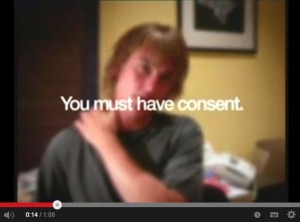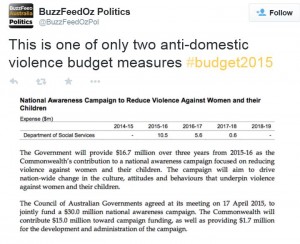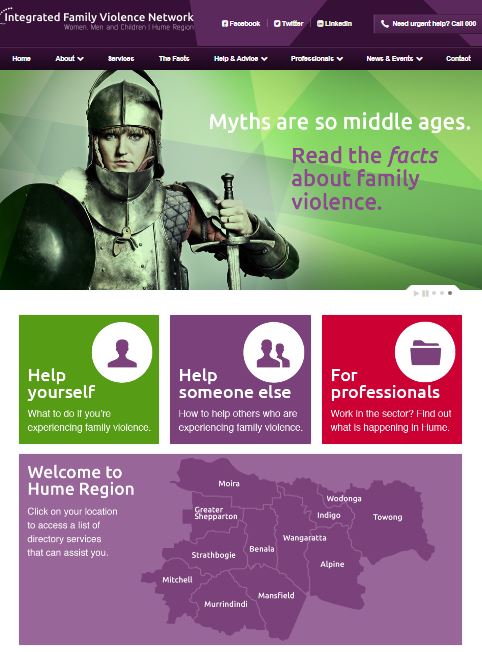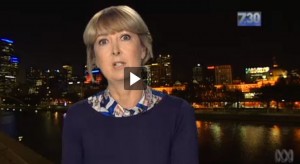Updated Tuesday May 12 2015 (Budget night)
Recent violence against women and children has the community appalled and politicians grappling for a response. Predictably our political leaders have swung behind an awareness campaign. The Federal Government pledged $16.7 million over three years in last night’s budget and COAG will throw in about $13 million more. It’s not often that you hear a marketer say this: but this time maybe more marketing isn’t the answer.
When non-marketing people refer to an awareness campaign, they usually mean advertising, typically on television, perhaps with a letterbox drop and celebrity YouTube thrown in. Badges are likely too.
Politicians are drawn to advertising as it’s easily understood and highly visible. Politicians of all persuasions are drawn to measures that help them to be seen to be doing something. Taxpayer funded advertising has recently asked us to stop smoking, get moving, screen for cancers, work safely and curb alcohol consumption in front of children. The list goes on. One oddly-specific campaign even warns us of the perils of swimming in flood waters. Do these campaigns work? To some degree, surely they do. However if they worked as well as agencies and their clients argued they do, we’d all be thinner, richer and happier than we currently are.
It’s true that long-term, high-priced marketing campaigns have helped us dramatically turn-around levels of smoking and driving fatalities but it’s too easy to give marketing all the credit. Changing drink-driving from a skill to a socially unacceptable behavior took education but has been underpinned by constant enforcement and legislation. Hard-hitting, award-winning and incredibly expensive television commercials are all well and good but booze buses, speed cameras, demerit points, court appearances and licence loss are the true secret weapons of that success.
Smoking rates have plummeted. Do we have marketing to thank? Partly; though government’s ability to squeeze smokers over the availability, cost and convenience of their vice is key. The fact that cigarettes lead to cancer hasn’t hurt either. Anti-smoking and road safety campaign briefs are a relative doddle when compared to domestic violence – and progress still took decades. Changing attitudes and behaviours to domestic violence is far more challenging and far less likely to succeed. It’s the Everest of social marketing campaigns.
Social ills such as drink-driving, smoking and obesity are topics that most of us – even those of us guilty of the ‘crime’- can discuss. Smokers admit to failed attempts to quit, the plump lament their excess kilos, those living in bushfire zones confess to their indecision to stay or go. This is bread and butter barbeque conversation with little social backlash.
Domestic violence is usually a dirty secret for victims and almost always so for perpetrators. Domestic violence has not has lacked for awareness-raising campaigns: The ‘Australia Says No’ campaign was a high-profile TV-driven campaign of the Federal Howard government. Did it help?

Another high profile campaign. Now loooong gone. We say NO to short-term, broad-based awareness raising.
More recently police, media outlets and sporting codes have lent their support to the cause. This is great of course. White Ribbon Day is a now major national happening. The ribbon has become synonymous with violence against women – we see it on the lapels of the powerful, on our public buildings and at major sporting events.
We’ve had a flurry of celebrity ambassadors and confessions, social media outrage and even a twice-yearly White Ribbon Cup between two AFL teams. This all helps create a culture that is unaccepting of violence and it should continue but there comes a time when marketing ends and reality begins. Domestic violence is well and truly on the agenda. What next?
Marketing has limits when it comes to changing attitudes and behaviors. Even under the best of circumstances, a good campaign must be long-term and specifically targeted to the key audiences and must evolve overtime to help people make a change. A good campaign leads to specific actions.
Experts with whom Hootville works tell us that enforcement and services are paramount. And that services are overwhelmed by demand. Campaigns eat up money. Awareness-raising campaigns are empty calories; feeling good in the short-term but amounting to nothing. Funds end up with consultants rather than services. And let us not forget that it is government that is accountable for the level of service and priority this issue and its victims receive. Will government be happy to see a campaign that lobbies for better services? We think not.
What would our desired actions be for a family violence campaign? Is it to encourage victims to leave to abusive situations? To inspire more reporting to police by family, friends and work-mates? How about tools for parents to raise less violent boys and less tolerant girls?
The ultimate creator of perception is reality. Every inadequate court sentence handed down to a violent criminal sends the message – ‘Violence is okay!’ Every video game aimed at young men with no female characters demonstrates that women don’t count. (Video games in which you can kill female prostitutes are surely an urban myth.) Every overflowing refuge says: “our care is finite.”
The CEO of Domestic Violence Victoria, Fiona McCormack put it beautifully in an interview on ABC1’s 7.30 when she explained the link between misogynistic attitudes and domestic violence. She compared it to the connection between increased levels of homophobia and attacks on gay people. This concept may be a bridge too far for some people.
Most professionals in the domestic violence sector would rather see money diverted from additional awareness-raising to bolstering the range of services offered to victims.
Whenever a victim of family violence summons the courage to leave, she needs shelter, services and support immediately and indefinitely. We need a justice system resourced and nimble enough to protect the innocent and deal with perpetrators. And when a victim reports a crime; she must feel confident that she will be believed, supported and protected. These are complex issues far beyond the remit of any marketing agency.

Working on some ideas for the little ladies. Seriously – this is EXACTLY how ad agency people are today. In Australia. In 2014.
“Can’t we have both services and marketing?” you ask. Well, based on the current inadequacy of services we can’t even get half of that mix right. Too often money that goes into campaigns directly comes out of services budgets.
Let’s leave the TV commercials and billboards for upcoming election campaigns. That said; there will be big ad agencies lining up to raise awareness at the expense of services. With respect to our peers (above): hands off.




